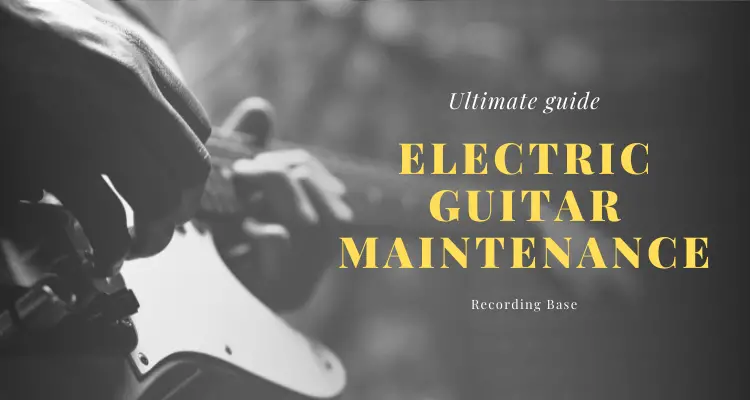This article is written and contributed by Erik from Instrumentio about avoiding the common mistakes when replacing guitar strings. Hope you’ll enjoy it…
If you play guitar, at some point you are going to have to replace the strings. It is inevitable when you are a guitarist as strings do tend to break fairly regularly.
Even if you’re the sort of gentle player who only gets a string break once in a while, replacing strings is still suggested regularly.
If you don’t, the tone of the guitar can start to suffer and they lose a lot of their brightness. Oil from your fingers can build up on the strings and degrade the quality.
Replacing guitar strings can look like witchcraft if you have never done it before. It’s easy to assume that it is really difficult, and when you see the strings wound around a headstock you might think it’s a tough skill to master.
Table of Contents
- 1 Avoid These Mistakes When Replacing Guitar Strings
- 2 Mistake 1: Getting the Wrong Strings
- 3 Mistake 2: Trying to Save Money on Strings
- 4 Mistake 3: Not Replacing the Strings One at a Time
- 5 Mistake 4: Not Looking After Your Strings
- 6 Mistake 5: Not Getting the Tension Right
- 7 Mistake 6: Not Neatening Up Afterwards
- 8 Conclusion
Avoid These Mistakes When Replacing Guitar Strings
In truth, it is relatively simple. However, there are some commonly made errors whether you are replacing electric or acoustic guitar strings.
We’ve covered the most common (and easily avoided) mistakes below to help you to stop getting caught in the traps and pitfalls some guitarists do when they first try to put on a new string, or a new set of strings.
There are plenty of guides out there that can show you the steps to take when you are changing the strings of your guitar, but not many will talk you through the potential pitfalls. So, what are the most common errors?
Disclosure: This post may contain affiliate links, which means we may receive a commission if you click a link and purchase something that we recommended. Read more about Affiliate disclosure here.
Mistake 1: Getting the Wrong Strings

No, I don’t just mean getting electric guitar strings and putting them on your acoustic guitar (though that is a bad idea, too).
There are lots of different types of strings out there, and while a poor brand shouldn’t damage your guitar, it is vital that you get the right gauge.
Gauge means the thickness of strings. Putting on the wrong gauge of strings, or the gauge that the guitar isn’t “used to” is a way to damage the guitar.
The gauge measurement should stay the same once you have got to the point where you have decided on the thickness you enjoy playing. Constant changing every time you replace strings is a surefire route to damage.
If you suddenly change to heavy strings (thicker) then it will pull the neck and change the “action” or the feel of the guitar.
If you change to a lighter, the truss rod on your guitar might overcompensate, and the action will lower, this means the strings will be closer to the fretboard and they may even buzz or rattle when played as they come into contact with the guitar.
There are lots of different types of strings out there and being able to change to a type that suits you can put another tool in your arsenal, but if you do, the whole setup of your guitar may need to change.
A music store should be able to help you if you are making drastic changes, as they can alter the tension and check the truss rod, so you can know that your guitar is properly set up.
Mistake 2: Trying to Save Money on Strings
It is hard to understand why anyone would spend large amounts of money on music gear and skimp on the accessories. This happens regularly, though. You can find many vocalists with expensive microphones and a terrible cable connecting it to the computer.
This tip is more about the brand than it is about getting a special offer. If you can get the same strings in bulk to save money or you can find a special deal at your local music store, then this is worth doing.
However, don’t sacrifice quality just to save a little bit of cash.
Poor quality strings won’t last as long and will lower the sound quality of your guitar.
The tonal sacrifice you will be making means that it simply isn’t worth it, plus, if you are having to replace your strings more regularly, you probably aren’t even going to save any money in the long run.
There are some very cheap alternative brands of strings on the market, but you should only buy brands you can trust.
Strings aren’t very expensive anyway, so the saving wouldn’t be significant. Your strings are an investment, and unlike accessories like straps, they directly impact the sound of your instrument.
Price isn’t the only factor that dictates how good strings are. Luckily, we live in the age of reviews. You can tell by reading reviews of products online and ensuring you get reliable and suitable strings.
Mistake 3: Not Replacing the Strings One at a Time

If you need to replace all of the strings on your guitar, a big mistake that is commonly made is taking all the strings off before you start to replace them.
This is not how it should be done. Remove one string, replace it, and then move on to the next string.
This might even go against your instinct. You might think it is a case of cutting all the strings away and then replacing them all, but this should never be done.
Guitars have a delicate balance of pressure, and it is easy to mess it up.
Most guitars feature a truss rod, which is a device that counters the tension of the six strings along the neck.
If you take the strings all off, the pressure can be overcompensated, and the neck can even bend! Guitars really do need to be looked after properly. Your guitar should not be bare of all strings, this is simply asking for trouble.
This is such an easily avoided mistake, but it is vital.
Some people also recommend tuning as you go, this will also help with the balance of the tension along with your guitar. Anything you can do to avoid the string pressure changing too much can help to avoid guitar issues such as warping.
Even high-quality woods can be susceptible to this issue. Warping makes the action of your guitar all wrong, or in extreme cases, it can make the guitar totally unplayable.
If you’ve spent a lot of money on your guitar, this is the last thing you will want to happen.
Mistake 4: Not Looking After Your Strings
This is not a mistake you are likely to make during your string change, but it is worth including in the list as it is a mistake almost every guitarist makes.
Guitars need to be looked after. Once you have finished playing, it should go away in the case, preferably in a case with the correct humidity.
It is amazing what can get on the strings just from coming into contact with your hands. This can make them sound dull, and shorten the lifespan of your strings, too.
Oils, acids and general dirt on your hands can get onto guitar strings and cause them to corrode. A string cleaner is a very small investment but it is one that is well worth making to ensure the strings can stay sounding good for as long as possible.
Keeping your guitar safely stored on a hanger, stand or within a case can ensure that it doesn’t succumb to the hazards of everyday life, either.
Ensuring you don’t knock it or let your cat or dog play with it may sound basic, but the strings are delicate, and they will be damaged more easily than most other instruments or parts of the guitar.
Properly clean and properly store, this will ensure that your strings don’t need replacing too regularly.
Mistake 5: Not Getting the Tension Right
Once you have put the strings in place on your guitar, it is time to tune-up. Obviously, this is essential if you are going to play the guitar straight away.
If you don’t plan to play it instantly, you might think that a rough tune or even no tuning at all is something you can get away with. However, this can lead to the tension along the fretboard not being correct, and warping can occur.
This means that it is vital to tune up as accurately as possible.
The guitar needs to be tuned not just to the E-A-D-G-B-E tuning (assuming that’s what you use) but the correct pitch of each of those notes.
It sounds obvious, but some absolute beginners can make this mistake, and think the guitar is tuned right when the string is tuned to the wrong octave (therefore, way too deep or way too high pitched).
If you aren’t sure, you should look at some YouTube videos on tuning and compare the tone of your guitar.
Though it might sound slightly different as it is a different instrument, the pitch of the strings should clearly be the same, otherwise, you need to tune once again.
Obviously, you should use a tuner but there can be errors as the strings detect which string is which, especially if your tuning is a long way from being accurate.
Mistake 6: Not Neatening Up Afterwards
Have you ever seen one of those guitars where the long strings come streaming out of the headstock? Some people do this as a stylistic choice.
The “rough and ready” look that can be cool, but it is definitely not conducive to the best guitar playing. Plus, you might find that these extra lengths of string get in the way.
It is not difficult to neaten up your strings. There is bound to be excess.
Strings are designed this way so that when you wind them, you can be sure that you have enough. However, it is simple enough to cut the strings.
Many people purchase a device such as a string winder and a cutter. These are affordable, and they make it really easy to wind the strings around and then cut away the excess. If you are tuning up for the first time, you might find this tool to be a godsend.
Conclusion
Changing strings is something that will probably eventually come as second nature to a guitarist, it is something that just needs to be done from time to time.
While the intention of this guide isn’t to scare, it is vital that you get the string changing right. You can do far more damage than the value of a set of strings if you don’t.
The delicate balance of the tension in your instrument needs to be looked after.
As well as following a step-by-step guide to replacing guitar strings, it is a good idea to go over the errors some other people have made.
This can ensure that you don’t fall into the same traps.
Read also,
- How to EQ Bass Guitar in Mixing [7 Killer Tips]
- Beginner’s Guide to Guitar Tabs [Essentials You Should Know]
Does changing guitar strings affect action?
If you change your guitar strings then it doesn’t directly impact action. If you notice action changes after replacing your strings then you should check the bow of your neck first.
Do I have to adjust truss rod when changing string gauge?
No, you don’t need to adjust truss rod in your guitar after changing guitar gauge. However, if it’s unbalanced you should do minor adjustments.
What happens if I tighten a truss rod too much?
A too loose truss rod results in a concave neck bow which means “action too high”, while a tighter truss rod which means action is too low, causes a convex neck hump which results fret buzz.
How straight Should guitar neck be?
I recommend an average gap of around 0.010 inches, between the frets and strings.






